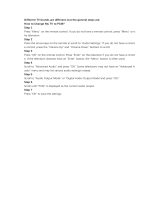
ADVANCED FuNCTIONS
GENERAL AVR SETTINGS
Network Settings
: When the AVR is connected to a home network router
using the Network Jack, you may play shared content stored on a PC or other
device connected to the network, and you may enjoy Internet Radio streams
when the network is connected to the Internet. If you are having difficulty
accessing these sources, check the Network Settings. Highlight the Network
Settings line and press the OK Button to view the Network Settings submenu.
ID #
• : This line is informational only, and identifies the AVR to
other devices on your home network and the Internet for www.
radioharmankardon.com.
Network Settings
• : If leaving this setting at “Automatic” does not
allow access, press the OK Button to change it to “Manual” and adjust the
other settings below it.
IP Address, Subnet Mask, Gateway, Primary DNS,
•
Secondary DNS
: Depending on your system, this information may
be set automatically and may change each time the AVR accesses the
network for a new listening session. Contact your ISP (Internet Service
Provider) for this information.
Proxy Address
• and
Proxy Port
: Some network security systems
access the Internet using a proxy server. Sometimes filling in just this
information correctly may resolve Internet access issues.
Volume Units
: Select whether volume is displayed in the conventional
decibel scale or on a numeric scale from 0 to 90. When the decibel scale
is used, 0dB is the maximum recommended volume, with lower volumes
displayed as negative values.
Volume Default
and
Volume Default Level
: These two settings are
used together to program the volume level at turn-on. Turn Volume Default
on, and then set the Volume Default Level to the desired turn-on volume.
When the Volume Default setting is left off, the AVR will play at the last-used
volume setting from the previous listening session.
Unit of Measure
: Adjusts the speaker-distance settings for Manual
Speaker Setup. Select between meters and feet.
Language
: Select the preferred language for the AVR’s on-screen menus
and displays: English, French, Spanish, German, Italian or Russian.
HDMI Audio to TV
: Determines whether HDMI audio signals are passed
through the HDMI Output to the video display. In normal operation, leave
this setting Off, as audio will be played through the AVR. To use the TV by
itself, without the home theater system, turn this setting On. Mute the TV’s
speakers when using the AVR for audio.
Dolby Volume Calibration
: This setting determines the Dolby Volume
Calibration Offset, as described on page 30 of the Basic Manual. Its default
of 0dB is best when the system’s loudspeakers have a sensitivity rating of
88dB (8 ohms, 1 watt, 1 meter). If your loudspeakers have a higher sensitivity
rating, increase the Dolby Volume Calibration setting by the difference
between your speakers’ sensitivity and 88dB. If your speakers have a lower
sensitivity, decrease the Dolby Volume Calibration setting by the difference
between 88dB and your speakers’ sensitivity.
Menu Appearance
Menu Transparency
: Select whether video programs will be visible
when the menu system is in use. Select Normal for a fully transparent
background, Medium for partial transparency or Opaque to block video
programs while the menus are on screen.
Volume Status Messages
: When the AVR is turned on, the volume
is adjusted or the source is changed, or if a change in the input signal is
detected, a status message will be displayed on screen. Select how long the
message remains visible, from 2 to 10 seconds, with a default of 3 seconds.
Select “Off” if you do not wish to see the status messages.
Menus
: The settings in the Surround Modes, Video Modes and Audio Effects
menus only remain in effect during the current listening session. This setting
governs how long these menus remain visible after the last adjustment: 5,
10 or 30 seconds, 1 minute or 5 minutes. Select “No Time-Out” to view the
menus indefinitely, but this setting is not recommended, due to the danger of
“burn-in” on some video displays.
Setup
and
Slide-In Menus
: This setting determines how long the setup
menus (Main Menu, Speaker Setup Menu, Zone 2 Menu, all slide-in menus)
remain visible after the last adjustment. Select a time-out period of 5, 10 or
15 (the default) minutes, or no time-out, which leaves the menus on screen
until manually cleared. A time-out period avoids the possibility of burn-in
damage to plasma or CRT displays.
Screen Saver
: Program a time-out period for no activity (with no menus
displayed) before the AVR’s built-in screen saver begins. Select a period of 5,
10, 20 or 30 minutes or 1 hour, or turn off the screen saver. A time-out period
avoids the possibility of burn-in damage to plasma or CRT displays.
System Information
Software Version
: This line is informational only. From time to
time, Harman Kardon Inc., may release software upgrades that improve
performance or add features. If you are experiencing difficulties with the AVR,
a customer service representative may ask for the software version of your
product to determine whether a later upgrade is available.
Upgrade Software
: If a software upgrade is released for the
AVR 760/AVR 660, installation instructions will be available in the Product
Support section of the Web site or from Harman Kardon Customer Service. At
that time, you may access this submenu to install the upgrade software.
NOTE
: During a system upgrade, do not power off the AVR or use any of its
controls. Doing so could permanently damage the AVR.




















